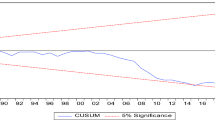Abstract
This work develops a model for minimum temperature in order to assess the weather related risk in agriculture industry. Non-linear autoregressive models with time-varying coefficients and volatility with various seasonal components and lags are compared in an appropriate model-selection algorithm using AIC. The optimal model is a time-varying autoregressive model which includes non-linear and seasonally-varying autoregressive terms as well as time-varying volatility. These models are then used to simulate future weather from which the probabilities of appropriate complex hazard events are estimated.









Similar content being viewed by others
References
Akaike H (1974) A new look at the statistical model identification. IEEE Trans Autom Control AC–19:716–723
Anderson PL, Meerschaert MM, Veccia AV (1999) Innovations algorithm for periodically stationary time series. Stoch Process Appl 83(1):149–169
Benth FE, Benth JS (2007) Volatility of temperature and pricing of weather derivatives. Quant Financ 7(5):553–561
Brockwell PJ, Davis RA (1991) Time series: theory and methods, 2nd edn. Springer, Berlin
De Livera AM, Hyndman RJ, Snyder Ralph D (2011) Forecasting time series with complex seasonal patterns using exponential smoothing. J Am Stat Assoc 106(496):1513–1527
Finley AO, Banerjee S, Ek AR, McRoberts RE (2008) Bayesian multivariate process modeling for prediction of forest attributes. J Agric Biol Environ Stat 13:60–83
Gladyshev EG (1961) Periodically correlated random sequences. Sov Math 2:351–358
Hastie T, Tibshirani R, Friedman JH (2009) The elements of statistical learning, 2nd edn. Springer, Berlin
Hosseini A, Fallahnezhad MS, Zare-Mehrjardi Y, Hosseini R (2012) Seasonal autoregressive models for estimating the probability of frost in Rafsanjan. J Nuts Relat Sci 3(2):45–52
Hosseini R, Le N, Zidek J (2012) Time-varying Markov models for binary temperature series in agrorisk management. J Agric Biol Ecol Stat 17(2):283–305
Hosseini R, Le N, Zidek J (2011) Selecting a binary Markov model for a precipitation process. Environ Ecol Stat 18(4):795–820
Jones RH, Brelsford WM (1967) Time series with periodic structure. Biometrika 54(3):403–8
Kedem B, Fokianos K (2002) Regression models for time series analysis. Wiley Series in Probability and Statistics
Richards TJ, Manfredo MR, Sanders DR (2004) Pricing weather derivatives. Am J Agric Econ 86(4):1005–1017
Schwartz G (1978) Estimating the dimension of a model. Ann Stat 6:461–464
Tesfaye YG, Meerschaert MM, Anderson PL (2006) Identification of periodic autoregressive moving average models and their application to the modeling of river flows. Water Resour Res 42(1):W01419
Tong H (1990) Non-linear time series, a dynamical systems approach. Oxford University Press, Oxford
Troutman BM (1979) Some results in periodic autoregression. Biometrika 66(2):219–228
Wang X, Smith KA, Hyndman RJ (2006) Characteristic-based clustering for time series data. Data Min Knowl Discov 13(3):335–364
Acknowledgments
We are indebted to Mr. Islami from Rafsanjan Weather Office for providing the data for this study. We are also thankful to Prof. Jim Zidek and Prof. Nhu Le for some fruitful discussions on the modeling and applications.
Author information
Authors and Affiliations
Corresponding author
Additional information
Handling Editor: Pierre Dutilleul.
The first author was supported by research grants from the Japanese Society for Promotion of Science.
Rights and permissions
About this article
Cite this article
Hosseini, R., Takemura, A. & Hosseini, A. Non-linear time-varying stochastic models for agroclimate risk assessment. Environ Ecol Stat 22, 227–246 (2015). https://doi.org/10.1007/s10651-014-0295-2
Received:
Revised:
Published:
Issue Date:
DOI: https://doi.org/10.1007/s10651-014-0295-2




